About the blog:
Rinchenpong is a small and beautiful town in West Sikkim near Gangtok. Just imagine yourself looking at the majestic Kanchenjunga range just after you wake up! Yes, Rinchenpong offers you just that! This quaint town is definitely less crowded than Gangtok and Pelling. So if you want to enjoy a peaceful weekend in the eastern Himalayas, then Rinchenpong is just the place for you! In this blog, we will tell you all about our experience at Rinchenpong, how to reach, where to stay and other relevant details.
Perched at an altitude of 5576 feet, Rinchenpong is like a breath of fresh air. This small town offers breathtaking views of the mighty Kanchenjunga ranges along with the abundant charm of forests and nature. Tucked away in West Sikkim, Rinchenpong is a place of peace. The quaint town is surrounded by green forests that are often sheathed in fog. No wonder the place is also known as Silent Valley!
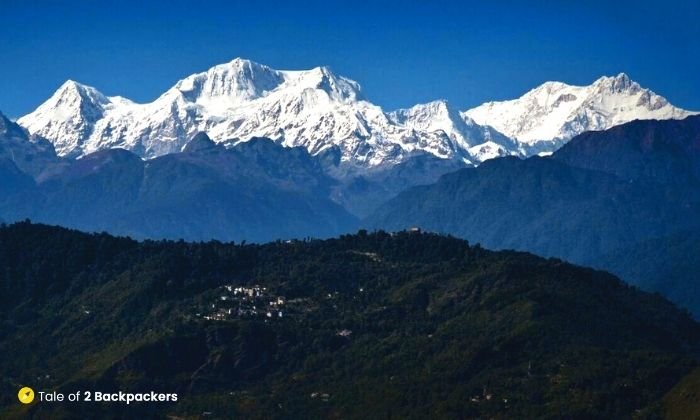
A lot of Himalayan birds are found in the forests of Rinchenpong. During the spring, the place comes to life with blooming rhododendrons, orchids and wild flowers and the winters are known for their breathtaking views of the Kanchenjunga ranges. Rinchenpong was once a muse for the famous poet Rabindranath Tagore who had written some illustrious verses in praise of beauty of the place.

Contents
Where is Rinchenpong located?
Rinchenpong is situated in West Sikkim, about 120 km from Gangtok. The distance from Pelling is only 35 km. Often Rinchenpong is visited as a day trip from Pelling, but I would suggest you to spend a couple of days in Rinchenpong, You cannot fully appreciate the beauty of this place if you do not stay here.

Rinchenpong Trip
Our visit to Rinchenpong was quite by chance. After completing the Barsey trek, we were wondering how to utilize the remaining two days we had. Our travel companion, Partha Da (who we met just a day before) mentioned Rinchenpong. Although a bit sceptical in the beginning, we decided to visit the place. We also managed to convince Partha da to come with us. He was, in fact, all ready to go back home, but we somehow managed to make him come with us. Who would say that we had met only 2 days back? It seemed we were travelling together for ages!

The three of us finally started from Hilley and reached Sombaria by shared jeep. From there, we hired to Rinchenpong. By the time we reached, it was evening and had started drizzling. The car dropped us at the market area, which in itself was just a small elevated place with a few shops around.
There were a few hotels at the market and a few homestays around Rinchenpong. We chose to stay at Hotel Landscape which was a little uphill from the market area and just in front of Rinchenpong Monastery. Though the name said hotel, it was more of a homestay.
The place was run by a Bengali couple who had permanently shifted from Kolkata to Rinchenpong. Friendly and talkative, that is what I would say about the couple. They entertained us with their never ending collection of funny and interesting stories. Besides, the grand views of Kanchenjunga from the terrace and rooms did not hurt either! It was already dark when we reached. We simply got our rooms, had dinner and tucked in for the night.
The next morning we were awakened by the sound of chanting of prayers. The Buddhist monks at the monastery were reciting their prayers and doing their rituals. And we could see the Kanchenjungha just from our window. What could be a better way to wake up in the morning?
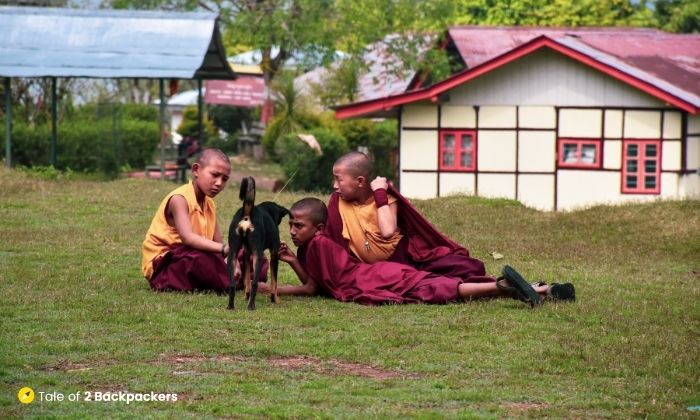
After a good breakfast, we decided to explore Rinchenpong. While we hand the option of getting a car, we wanted to explore the place on foot. It turned out to be a good plan because we literally explored almost every nook and corners of the place. So let me tell you the places we visited in Rinchenpong.
Places to visit in Rinchenpong
Rinchenpong Monastery
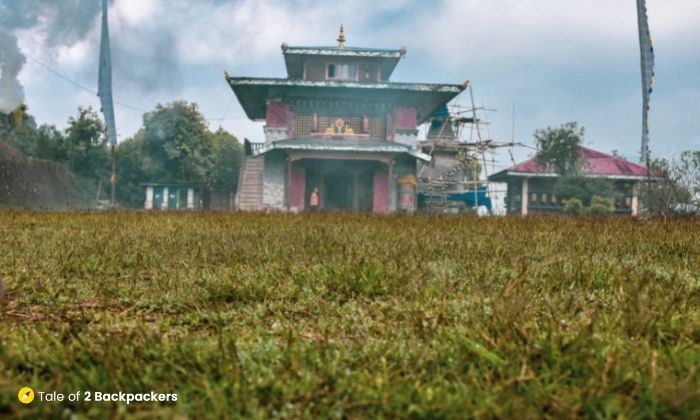
The 286 years old Rinchenpong Monastery was our first stop for the day. After all, it was just in front of our homestay.
The monastery built in 1730 was a quaint little structure with colourful decorations and prayer wheel at the side. What was interesting about the monastery was the statue of Gautam Buddha. The statue was that of “Ati Buddha”, the idol of the Buddha was in “Yab-Yum” position.

The locals believe that such a statue of Buddha is very rare. Infact, Ati Buddha statues are found in those monastic orders which are followers of “Tantric Buddhism”. With the prayer flags stuttering along, the place had a serene effect. You can simply sit down on the ground in front of the monastery for hours and absorb the natural beauty and peace.
Poison Lake or Bikh-Pokhri

This is another interesting place in Rinchenpong. The name Poison Lake itself is quite intriguing. When we heard its story, we were equally fascinated. The place is said to historically quite important for the Lepchas in Sikkim.
The story of the Poison Lake
It is said that in 1860, a British troop had arrived at the outskirts of Rinchenpong to invade independent Sikkim. They had pitched their tents beside the Poison Lake. The local Lepchas very cleverly mixed a concoction of poisonous herbs to the waters of the lake. The lake was the only source of water and the British troop drank the poisonous water. As a result, most of them died or were severely ill. Facing such a catastrophe, the British had no other option but to retreat and the Sikkimese rejoiced.

At present, the lake is all dried up and serves as a cricket ground for the youths. Only during the monsoons water the lake is rain fed. But there is also an interesting twist here. The locals believe that the lake is haunted! In the morning, they play cricket over the lake merrily, but after the sunset, none of the locals dare to venture near the Poison Lake.
The road to the Poison Lake was deserted and the canopy of trees made sure that very little sunlight reached the road. It definitely had an eerie feeling!
Resume Monastery

Resume Monastery is almost 300 years old and stands high up on a hill. A 1.5 km forest trail with stairs leads to the monastery. We followed the stairs and a few minutes of hiking brought us into the middle of the forest with dense vegetation and the mellifluous sound of birds.

The silence of the place was soothing. After a hike of about 40 minutes, we saw the tip of a Chorten. So we had finally arrived! A few more steps and we stood in front of a dilapidated old structure.

Unfortunately, the monastery was closed that day. We sat down at the stairs of the monastery when 2 persons came up. They had come to collect mushrooms from the forest. They told us that the monastery remains closed and unattended for most of the time as a case of land dispute is going on. The owner of the monastery is in a legal dispute with the Sikkim State government regarding the ownership of the monastery. The monastery now neither has any monks attending it nor does it remain open. It is a pity that such a rich and cultural place was simply lying unattended without any care.
Traditional Lepcha House

The traditional house is located somewhere near the Poison Pokhri as per the tourist map. We walked around the place but could not find the place. The traditional house is made of stone having colourful window and has various geometrical designs.
Shanti Van
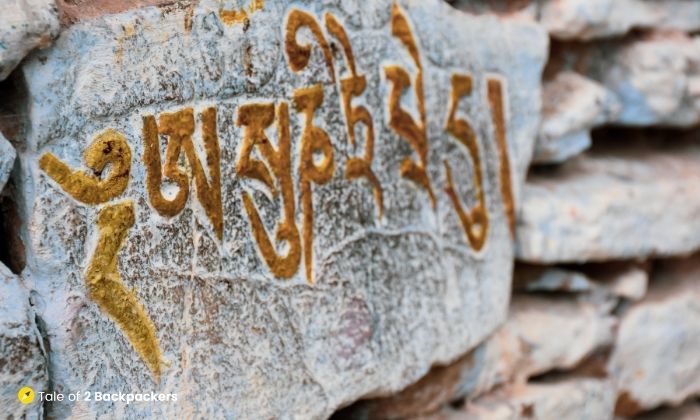
Located quite close to Resume Monastery, Shanti Van is literally a place of peace. You will get a panoramic view of the surroundings from here. There are a few ruins of Tibetan stupas, murals and inscriptions. It is believed that the Tibetan monks had hidden their treasures beneath these stupas!
Rinchen Choling Monastery and Rabindra Smriti Van
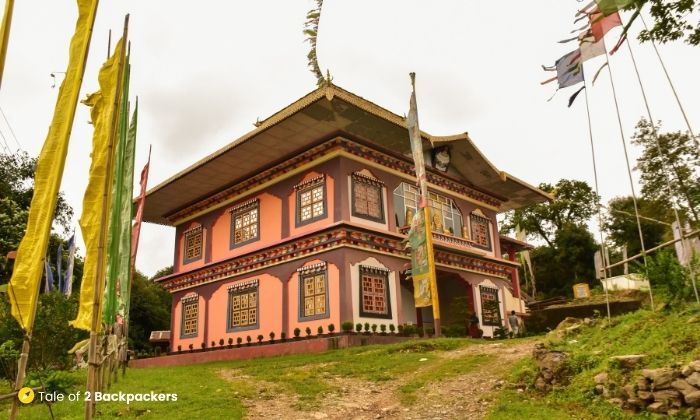
Rinchen Choling Monastery is located near Rinchenpong Bazar at Maggi Dara and it took us a long walk from the Rinchenpong Monastery to reach there. You can also take a car to the monastery. This monastery was built only in 1996 on the ruined site of a tshamkhang (A retreat hut where a monk goes for meditation and retreat for a period of 3 to 6 months). The monastery is bright red in colour witrh fluttering prayer flags around. The place looks quite peaceful and we got a lovely view of the surroundings from there.
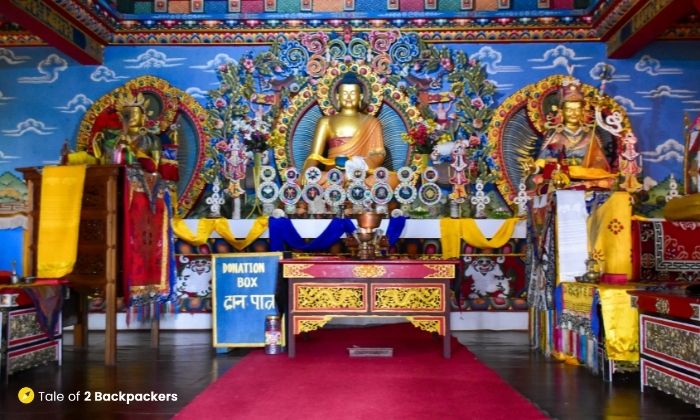
There is a footpath from the monastery that leads to Rabindra Smriti Van. This place is dedicated to Tagore and contains plaques of poems written by him.
Azing’s Farm
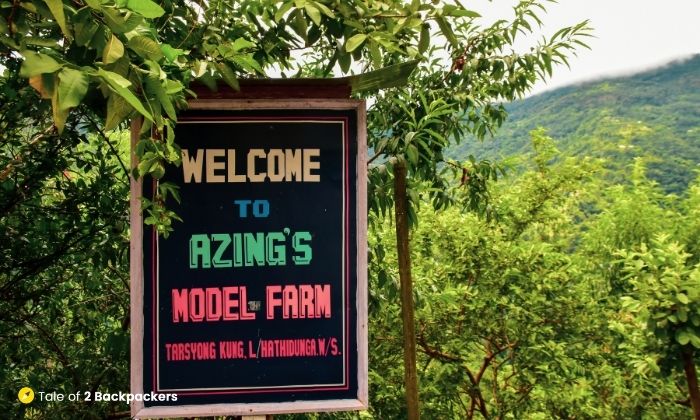
Azing’s Model Farm is a special place. Located about 6 km from Rinchenpong at Hathidunga on the Rinchenpong-Reshi Road, Azing’s Farm is a sight to behold. You have to climb down a number of steps to reach a wonderland, a fascinating example of progressive farming.
Spread across an area of 5 acres, the farm on the hilly slopes is truly a horticulture model. You will find pineapples, guavas, cherries, oranges and even grape vines here. Cardamoms, tomatoes, and various other vegetables and fruits are grown in the farm. The owners brew a variety of homemade wine and they are sold at a shop in the farm. You will also get honey and pickles there.
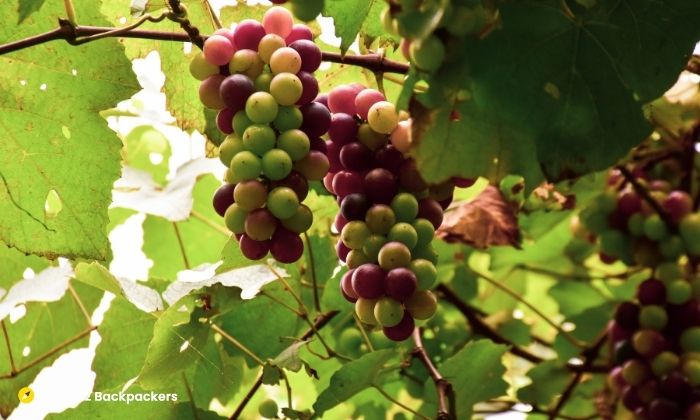
The spectacular views of the emerald green mountains, rolling clouds are simply an added bonus. There is a homestay at the farm and you can stay there if you so decide.
We visited Azing’s Farm the next day of our stay before starting towards Siliguri. We spent a considerable time there, talked with Mr Azing Lepcha, the owner, had a fill of pineapples and bought cherry wine and honey for home.
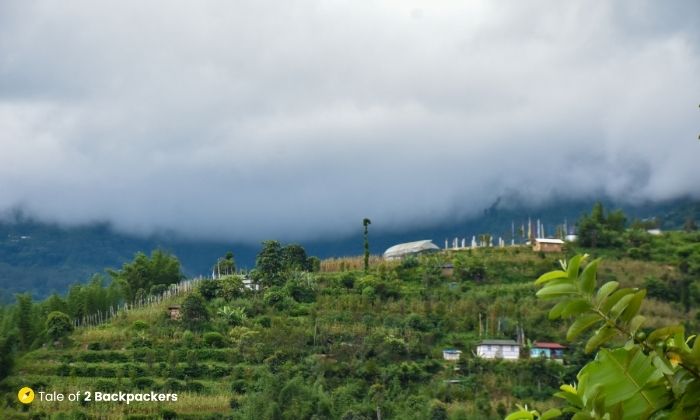
We explored Rinchenpong to our hearts content. We simply walked lazily around the place savouring each and every moment of the freedom we got – freedom from the chores of daily life, freedom from any deadlines and finally freedom from our phones and laptops which had so much eaten into us. The day we spent at Rinchenpong was so delightful and the break so refreshing. The place has really become special to us.
You can also visit other offbeat places in Sikkim from Rinchenpong. Kaluk is only 3 km from Rinchenpong and is equally beautiful. You can also visit Darap, Hilley, Ohkrey and go for Varsey trek from Rinchenpong.
Some useful facts about Rinchenpong (FAQs answered)
The nearest airport is Bagdogra Airport, almost 127 km from Rinchenpong. The nearest railway station is at New Jalpaiguri (NJP), 124 km from Rinchenpong. To reach Rinchenpong, you can hire a car from Bagdogra, NJp or Siliguri. Budget travellers can take a shared jeep from Siliguri Stand to Jorethang and from there take another shared jeep to Rinchenpong.
Alternatively, you can also reach from Gangtok and take a car to Rinchenpong.
There are a few hotels in the market area as well as a number of homestays at Rinchenpong. We stayed at “Hotel Landscape” and it was worth every penny. There is also a heritage stay at Rinchenpong where you can experience Sikkimese hospitality at best. Here are a few names and contact of places to stay at Rinchenpong.
Hotel Rinchenpong Nest: +91 7432021509
Yangsum heritage Farm : +91 9434179029
Hotel Landscape : +91 9434179029
Ghonday Village Resort, Kaluk: +91 9593979695
It is better to have your meals at the places you stay. The homestays provide some of the best and tasty meals. We personally enjoy eating at the homestays themselves.
The best time to visit Rinchenpong depends on what you want to do in your visit.
April – June
If you are fond of flowers and colours and want to avoid the summer heat, then April to June is a good time. The weather remains pleasant and theentire vista becomes gorgeous with blooming flowers.
July – September
The monsoons are beautiful with dreamy landscapes as Rinchenpong remains shrouded in a veil of mist. Rainfall is moderate, but do carry your rain jackets or umbrella. Also, beware of leeches. Carry a pouch of salt with you to ward off leeches.
October – March
Winter and spring are the time for bird watching and trekking. You will also get the best views of Kanchenjunga ranges during this time. With the onset of spring, flowers starts blooming as well.
A few more Photographs of Rinchenpong


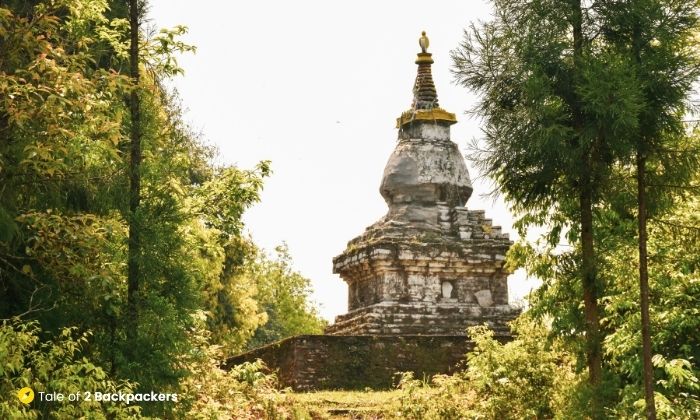

Are you planning to visit Rinchenpong anytime soon? Hopefully, this blog will help you plan your trip.
If you like this blog, please share it with your family, friends and neighbours.
Pin it for a later read!






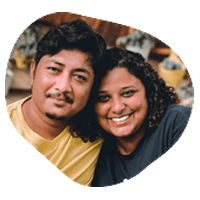
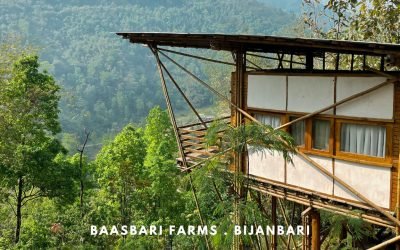
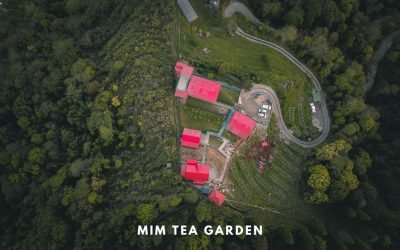
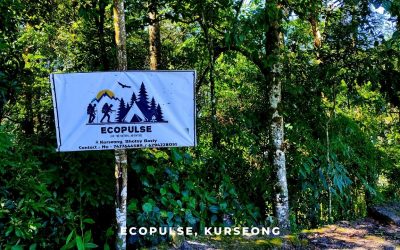


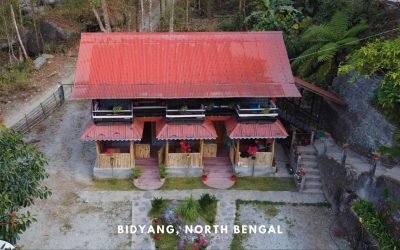
I like the place. And I am about to go there within few days. But fortunately I have 3 or 4 nights to spent. I want to spend one or two days at rinchenpong and rest on some other places. I am willing to move by trekking.
Can you suggest me, how I can plan this trip?
Hello Subrata! You can stay 2 nights in Rinchenpong and then head towards Uttarey or Okhrey for another night. Hope this helps.
Very interesting place.
Yes it is! Hope you visit there soon.
Great post.. absolutely stunning captures..
Very interesting. Reading about this place for the first time